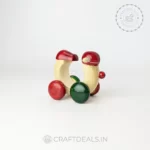- What are Channapatna toys?
Channapatna toys are traditional handmade wooden toys that have been made in the Channapatna region of India for centuries.










- Where is Channapatna located?
Channapatna is a town located in the Ramanagara district of Karnataka, India. It is situated about 60 kilometers from Bangalore, the capital of Karnataka, and is home to many traditional artisans who craft Channapatna toys.
Channapatna is also called as “Goombegala Ooru”, meaning toys town in English.
- What is the history of Channapatna toys?
The art of Channapatna toy making is believed to have originated in the 18th century, when the ruler of Mysore, Tipu Sultan, invited artisans from Persia to teach the local people the art of lacquerware.
- Who is the father of Channapatna toys?
Bavas Miyan is known as the Father of Channapatna Toys for his commitment to helping the local artisans and bringing in new technologies to improve the craft.
- What are Channapatna toys made of?
Channapatna toys are made from wood, primarily the Aale Mara tree, which is native to the Channapatna region of India. The toys are handcrafted using traditional techniques that have been passed down for generations.
The materials used to make Channapatna toys also include red sandalwood, coconut, rosewood, and other locally available woods. The pieces are painted with natural dyes such as turmeric, lac, and other natural ingredients.
- What are the traditional techniques used to make Channapatna toys?
The traditional techniques used to make Channapatna toys involve carving the toys from wood and then applying layers of natural dyes and lacquer to create the intricate patterns and vibrant colors.
The dyes are made from a variety of materials, including vegetable, turmeric and mineral pigments, and the lacquer is made from the resin of the Aale Mara tree, which is native to the region.
- What is special about channapatna toys?
Channapatna toys are special for a number of reasons:
- Handmade: Channapatna toys are handmade using traditional techniques that have been passed down for generations. Each toy is crafted with attention to detail and care, making them unique and one-of-a-kind.
- Materials: Channapatna toys are made from wood, primarily the Aale Mara tree, which is native to the Channapatna region of India. The toys are then coated with layers of natural dyes and lacquer, which are made from a variety of materials, including vegetable and mineral pigments and the resin of the Aale Mara tree.
- Durability: Channapatna toys are known for their durability and can last for many years with proper care. They are made from high-quality wood and are crafted with attention to detail, making them less prone to wear and tear.
- Educational value: Channapatna toys are not only fun to play with, but they can also be an excellent educational tool for children. As children play with these toys, they can develop fine motor skills, hand-eye coordination, and problem-solving abilities.
- Non-toxic: Channapatna toys are made with non-toxic materials and are safe for children of all ages.
- Environmental friendliness: Channapatna toys can be considered more environmentally friendly than mass-produced plastic toys. They are made from natural materials.
- What is the GI tag for Channapatna toys?
The GI tag for Channapatna toys was granted in 2005, in recognition of the craft’s uniqueness and significance. The tag ensures that the craft is protected and preserved and that only genuine Channapatna toys can be sold.
- How has the market for Channapatna toys expanded?
The market for Channapatna toys has expanded globally, due to the increasing demand for traditional, handmade toys. The GI tag has also helped to promote the craft and ensure that only genuine Channapatna toys are sold.
- Are Channapatna toys popular internationally?
In recent years, Channapatna toys have gained international recognition and have become popular with collectors and families around the world. The art of Channapatna toy making is now recognized as a UNESCO Intangible Cultural Heritage, and efforts are being made to preserve and promote this traditional craft.
- Are Channapatna toys safe for children?
Yes, Channapatna toys are made with non-toxic materials and are safe for children of all ages.
- Are Channapatna toys educational?
Yes, Channapatna toys can be an excellent educational tool for children. As children play with these toys, they can develop fine motor skills, hand-eye coordination, and problem-solving abilities.
- Are Channapatna toys environmentally friendly?
Yes, Channapatna toys can be considered more environmentally friendly than mass-produced plastic toys. They are made from natural materials and are crafted using traditional techniques, which can have a lower impact on the environment compared to mass production processes.
- What are the challenges facing the Channapatna toy industry?
The Channapatna toy industry faces various challenges, including a lack of resources, declining demand, and competition from cheaper, mass produced toys. Additionally, talented artisans are leaving the industry due to lack of job security and inadequate wages.
- How long do Channapatna toys last?
Channapatna toys are designed to be durable and withstand the rigors of play. They are made from high-quality wood and are crafted with attention to detail, making them less prone to wear and tear. As a result, they can last for many years with proper care.
- How can I clean and care for my Channapatna toys?
To clean your Channapatna toys, you can use a soft, dry cloth to wipe away any dirt or debris. If the toys are particularly dirty, you can use a damp cloth to gently wipe them down, but be sure to dry them thoroughly afterwards to prevent the wood from warping or splitting.
To protect the toys and keep them in good condition, you can apply a light coat of beeswax or other wood conditioner as needed.
- Can I customize Channapatna toys?
Yes, for some Channapatna toys we offer the option to customize toys with specific colors or designs. However, this will depend on the availability of materials. It’s best to contact us directly to inquire about customization options.


